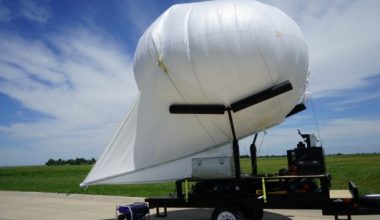 Quickly deployable aerostats with high resolution, day-night cameras, can be put in place in response to disaster recovery, threat tips, and daily port management.
Quickly deployable aerostats with high resolution, day-night cameras, can be put in place in response to disaster recovery, threat tips, and daily port management.
CONCEPT: Judicious placement of an aerostat with a high resolution, day-night cameras, and communications nodes can significantly enhance the effectiveness of port communications, data transmission and situational awareness. The persistence of the aerostat enables more affordable coverage, on a dollars per hour basis than aircraft, UAVs, or satellites. Automatic Identification System and Specific Emitter Identification payloads are available options. For long-range surveillance, out to about 90 miles, large aerostats with synthesized radar-camera systems are available.
FUNCTIONS: SkySentry’s Tactically Expedient Aerostat—34 M3 (TEA-34) Aerostat and larger models up to 100M3 are fully integrated with surveillance cameras and networked communications. Of course, the TEA can easily be integrated with current customer payloads as well.
A small, short-range TEA, flying at about 500 feet, can:
- Provide high resolution, day-night coverage of port or harbor activities, with Pan-Tilt-Zoom cameras, capable of automatic tracking of vessels, with results easily published to controlled websites
- Enable publishing of tracking data to Ops Centers and internet for remote viewing
- Establish line-of-sight connectivity among network participants to ranges in excess of ten miles, for security vessels, supervisors, and workers
- Provide telemetry links from shore workers, boats, and other vehicles to relay origin, destination, speed, precise location, and other data
- Disseminate various types of sensor data, to and from mission command
Large, long-range Heavy Expeditionary Aerostats, flying up to 3,000 feet or more, can:
- Elevate synthesized radar-camera payloads, in which the radar cues the camera, to observe vessels out to about 90 miles
- Enable consolidated radar-camera common operating pictures to Ops Centers
- Integrate with AIS, SEI, and other sophisticated payloads to help with recognition and identification of the target



